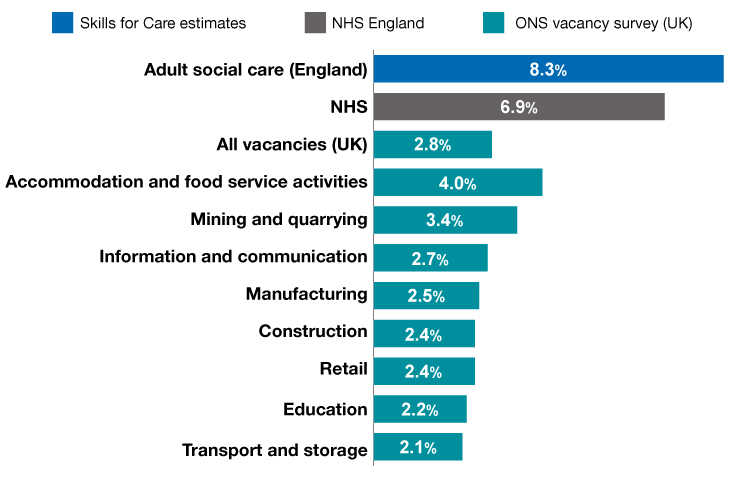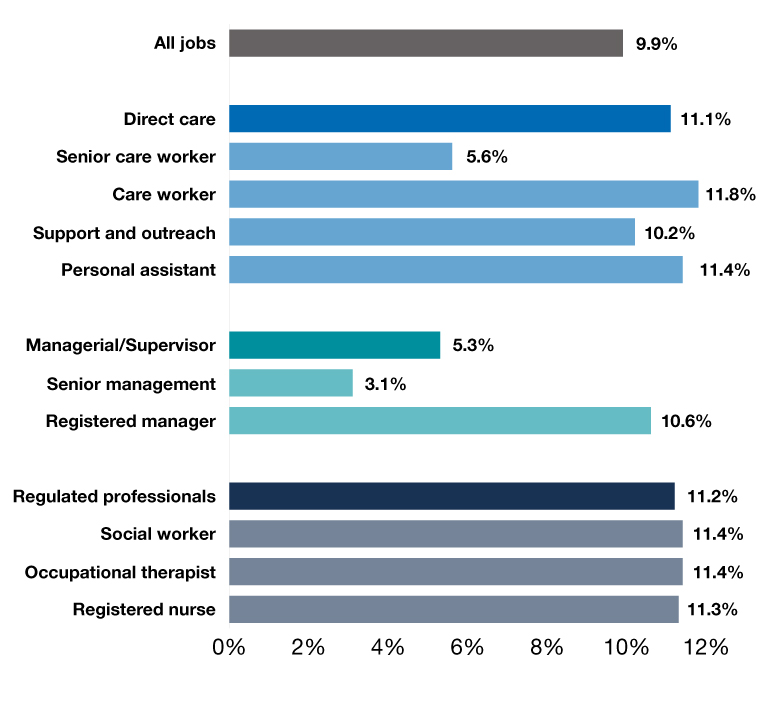The workforce in adult social care today
There are several key elements that impact the adult social care workforce today:
The social care workforce has grown by 210,000 (14%, or an average of 19,000 a year) since 2012. But, if we need to recruit an extra 540,000 posts by 2040, that equates to an average of 36,000 new posts every year from 2025 – and more than that over the next 10 years, when the over-65 population is forecast to grow more sharply. This does not consider the high turnover rate, which was 28.3% across the sector in 2022-23 and even higher for under-20s and registered nurses at 54% and 32.6% respectively. It also does not consider a high vacancy rate of 8.3% in 2023-24 (which is even higher for registered managers, nurses and care workers) which makes filling these positions even harder. This strains existing staff and affects the quality of care provided.1
The following chart shows the adult social care vacancy rate in comparisons to the NHS and the wider economy 2023-24.

The adult social care workforce lacks gender and age diversity. In 2022-23, the workforce gender split was 81% female and 19% male. We need to encourage more men into social care. The average age was 45, with 29% aged over 55, potentially nearing retirement. While diverse ethnicity exists, it is not reflected in leadership positions.
The following table shows the estimated proportion of the adult social care workforce by ethnic group for selected job roles. Source: Skills for Care estimates, 2022-23.
| | White
| Mixed/
multiple
ethnic groups
| Asian/Asian
British
| Black/
African/
Caribbean/
Black British
| Other
|
|---|
| All roles |
73% |
2% |
9% |
14% |
1% |
| Senior management |
83% |
2% |
7% |
8% |
<1% |
| Registered manager |
81% |
1% |
7% |
11% |
1% |
| Social worker |
72% |
3% |
6% |
18% |
1% |
| Occupational therapist |
83% |
1% |
4% |
11% |
1% |
| Registered nurse |
56% |
3% |
21% |
18% |
2% |
| Senior care worker |
75% |
2% |
12% |
11% |
1% |
| Care worker |
70% |
2% |
10% |
17% |
1% |
| Support and outreach |
75% |
2% |
5% |
18% |
1% |
| Personal assistant |
84% |
1% |
7% |
5% |
2% |
The strength of social care is in celebrating, valuing and recognising what makes people unique and supporting them to overcome challenges. It is vital that the adult social care workforce reflects the society we live in, and that people feel included and treated equally.
Learning and development is important in social care to give people the skills they need in their roles. People with a relevant social care qualification have a significantly lower turnover rate (26.5%, as opposed to 37% for those holding no relevant qualifications), while those receiving regular training in their role also have a lower turnover rate (31.6%) than those who do not (40.6%).2
We see people having to repeat training because employers are worried about the quality of previous training. Employers can find it hard to source and fund good quality training and cover backfill and staff can find it hard to understand their career pathways and opportunities.
With a 75% reduction in apprenticeships in adult social care since 2016 and low achievement rates3, there are significant issues with the apprenticeship structure in adult social care. In 2022-23 the overall achievement rate across all sectors was 54.3%. For adult social care, more than 60% dropped out of the level two and level three apprenticeship and more than 70% dropped out of the level five.
Social care struggles with apprenticeship shortages due to:
- Low funding: adult social care apprenticeship funding is £4,000, compared to £5,000 for a cleaning hygiene operative or £11,000 for a hair professional. Nearly 200 training providers have stopped delivering the levels two and three apprenticeships in social care since 2019.4
- The diploma and the apprenticeships are too similar. Candidates drop out of the apprenticeship once the diploma has been achieved and before they must do the end point assessment.5
- Employers are concerned with the 20% study time and the lack of backfill funding, which are a challenge with stretched resources.
The 'People at the Heart of Care' white paper6 and reform programme delivered by the Department of Health and Social Care (DHSC) should start to address some barriers around learning and development. There is still much to do given that only around half of the non-regulated adult social care workforce held a relevant social care qualification (46%), while 54% had no relevant social care qualifications recorded.7
Social care struggles to recruit and keep registered nurses, social workers and occupational therapists. These critical roles have high vacancy rates and turnover, hindering efforts to meet future needs for complex care, prevention and assessments.
Registered nurses working in adult social care, of which there are around 33,000 (plus about 750 nursing associates), provide vital support for complex needs, but their numbers have shrunk (down 18,000 filled posts or 35.3% since 2012-13) and have a high turnover rate (32.6%) compared to 10% for NHS nurses.
Social care relies on 23,500 social workers for complex and vital tasks like assessments, care planning and safeguarding and we do not currently have sufficient numbers. They are responsible for safeguarding and undertaking vital roles like approved mental health professionals and best interest assessors. In 2022, when charging reform work was progressing, the County Councils Network estimated that 4,300 more social workers would be needed for the additional 105,000 care needs assessments.8
Social care has around 3,800 occupational therapists helping people maintain independence and wellbeing through daily activities and community connections. We have more than 1,000 qualified occupational therapists working in other practitioner or management roles.
The following chart shows the estimated vacancy rate by selected job role, 2022-23. Source: Skills for Care estimates

Registered managers are crucial for adult social care. We have around 25,000 registered managers and they oversee care services, manage staff and finances, and ensure quality care is delivered. This highly skilled role requires registration with the Care Quality Commission (CQC). The individual though does not register with a professional body and it is not a regulated role like nurse, social worker or occupational therapist, who are registered with their respective regulatory bodies (for example, Nursing and Midwifery Council for nurses) and are held to specific professional standards and codes of conduct. This is, we assume, because registered managers do not primarily provide direct support to individuals and the Health Act 1999 clause 60 makes it clear that in England, we regulate a workforce for the protection of the public.
Stable management is vital for high-quality care (as shown through the link with stable managers and higher CQC ratings9), and there is a current shortage, with high vacancy rates (10.9%) and many managers (32%) nearing retirement. Succession planning is essential to ensure that services continue to provide well-led, consistent quality care.